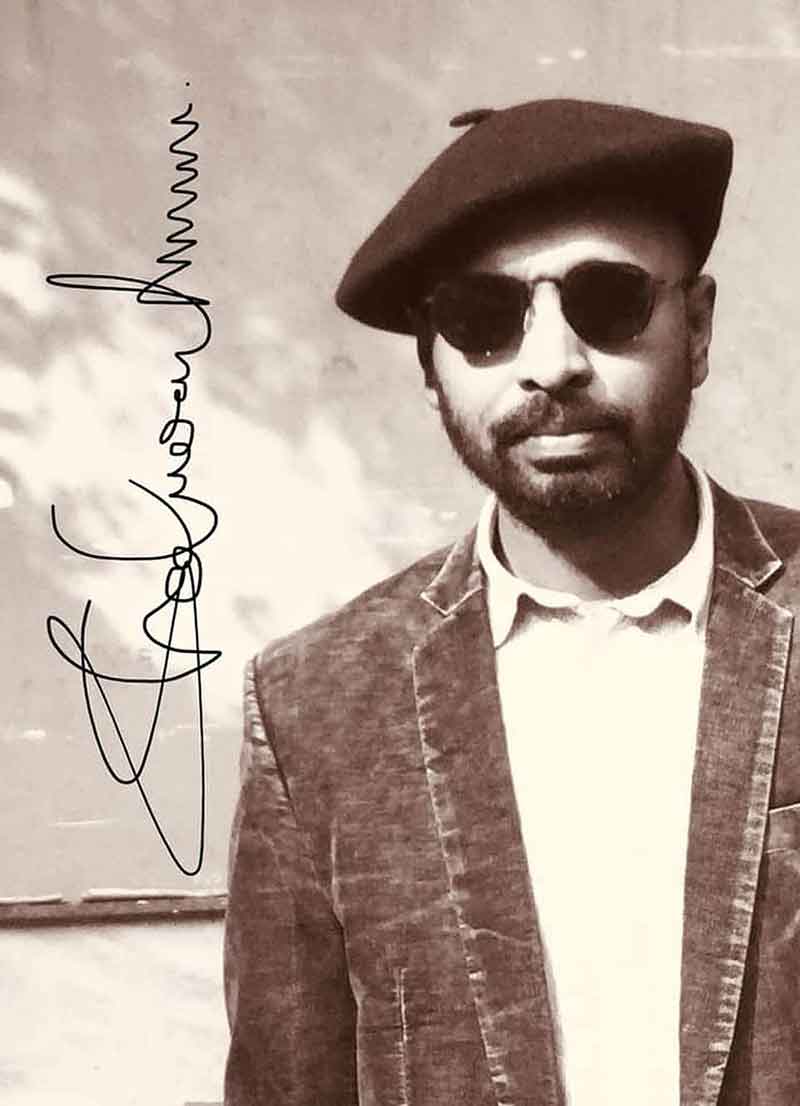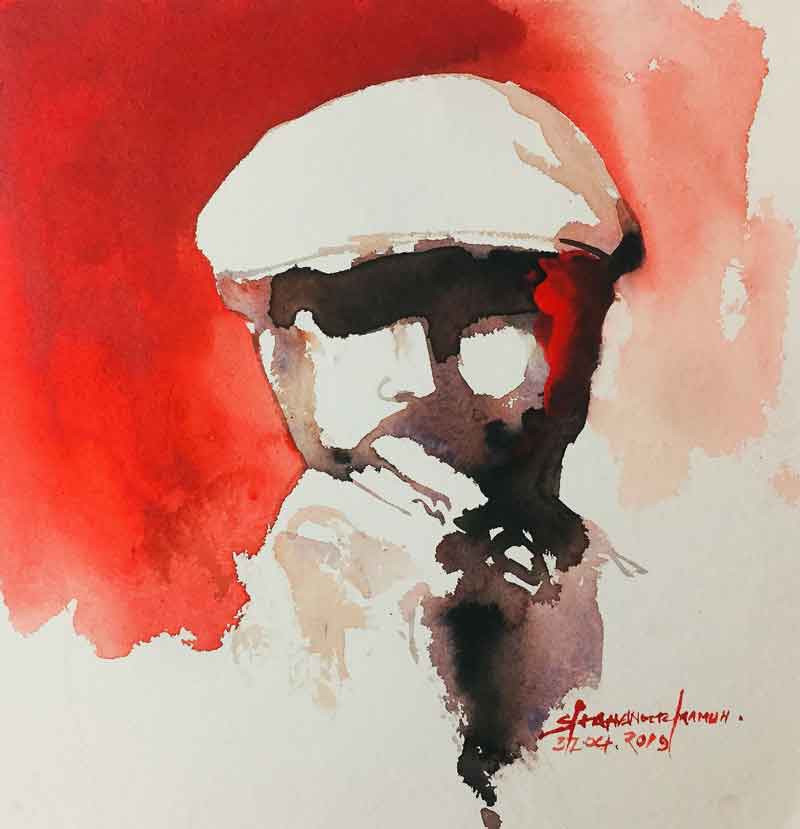SHAHANOOR MAMUN
Life is Watercolour

Drenching mysterious nature with water
Takir Hossain
Landscape painting or nature-based painting is the depiction of natural scenery where the main subject gets a wide view — with its elements arranged into an intelligible composition. Landscape views in art may be entirely imaginary, or copied from reality with varying degrees of accuracy. Painters often start their journeys with the portrayal of nature capturing what different seasons bring into view. The prime reason behind this is that nature’s beauty enthralls them and arouses their emotions through which they register various nuances of the mind. Being a landscape painter, Shahanoor Mamun’s engagement with nature is evident in his works of the last 20 years. With a skillful handling of watercolour, its various degrees of transparency and translucency he explores the medium to his advantage, Mamun considers his art as a way for him to “converse with nature.” Through its depiction, nature becomes an endless source of visual splendour and mystery for him.
Birth, upbringing and education
The artist was born in 1986 at Dapunia village in Mymensingh where the Sutia River quietly flows the year-round. Mamun embarked on his primary education in his area which is recognised for its rustic magnificence and marshlands. He passed his childhood by the banks of the Brahmaputra River and Sutia River which run very near to his native land.
Especially, the river of Brahmaputra greatly motivated him to draw its surroundings, aquatic life, limitless sky over the river and unbound river. Brahmaputra River seemed to Mamun a source of inspiration, as he took his subjects of paintings and resources from it. Skipping classes at school, he enjoyed seeing sailing boats, boatmen singing, riverine life and green grandeurs. During this time he used to portray them with his novice hands. Once, he suddenly took the chance to visit the Zainul Abedin Sangrahashala and got admission at Zainul Abedin Art School which was the part of Sangrahashala. He took lessons from there for one year and learned many methods of arts elaborately. During that time, Mamun learned many techniques from his drawing and painting teacher Zainul Abedin Tarafdar who also told him about Dhaka Charukola (now the Faculty of Fine Arts, University of Dhaka). From that time, Mamun started to mentally prepare himself for getting enrolled at Dhaka Charukola. In this regard, Mamun’s mother also greatly inspired him. Mamun completed his SSC and HSC respectively from the Hazi Jalaluddin Pre Cadet and High School and the Nasirabad College in Mymensingh.
Afterwards, Mamun got enrolled at the Department of Ceramic, University of Dhaka. He commenced as a ceramic artist as he likes to experiment with soil. But watercolour remained his passion and he frequently visited Buriganga River, Waiz Ghat and other panoramic places to portray nature. In 2008, he portrayed a watercolour on rainy day which got Honourable Mention Award at a group art exhibition where painters of different ages from Greater Mymensingh District participated. This recognition provided a great boost to his morale and marked a turning point in his life. From then onwards, he dedicated himself more with watercolours. The medium flows through his bloodstreams and he keeps himself earnestly occupied with it. As his skills started to blossom, Alliance Francaise de Dhaka took an interest in him and invited him to organise a solo watercolour exhibition in 2013. Since then, Mamun has been regularly invited from diffrerent galleries and art institutions for attending different workshops, art camps and group exhibitions.
Themes and philosophical aspects
By now, Mamun has established himself as a nature watercolourist. His keen aptitude involves drawing the philosophical aspects of nature, its volumes and colours to create sensitive vibes. The painter feels that the nature is an endless source of splendour and mystery. He finds inspiration in the elaborate detailing of the mystical essence of moonlit-night and singing crickets, light filtering through leaves, flora and fauna, silence of dense forest and foliage, drizzling rain, the play of light and shadow and many others. Each of these elements contains a new story for him and an invitation to embark on a new journey. He has also painted different types of boats from different localities of the country. Besides, Mamun ardently paints Old Dhaka with its vivacious activities, downtrodden people, rickshaws, traditional horse carts, narrow alleys, condensed habitations, wrecked buildings, cluttered wires scattered across roads, etc. Mamun has the ability to create an authentic setting as a backdrop for themes to intensify the drama. He has used quiet colours and tones where Old Dhaka’s socio-economical and cultural structures, urban hustle and bustle, architectural and structural improvements have also been highlighted. Meticulous depictions of Tati Bazar, Shakhari Bazaar and streets overwhelmed with rush hours, rain drenched outlines and more are evident in his works. In his depictions, he casts landscapes in a vital synchronisation in themselves.
Techniques and mediums
In his career, the artist has developed an individual style particularly in watercolour medium. He prefers the medium firstly and foremostly for its trait of articulateness. The medium’s lucidity gives him a liberty to impart his creativity smoothly. He has used a number of watercolour techniques like flat wash, dry flat wash, plein water and wet flat wash. Some of his watercolours have also been done through agile brushstrokes. He possesses adequate persistence and potentials necessary for transforming visual insights of the world into a heart-rendering portrayal. He draws pleasure from watercolours which enable him to interpret his inner thrivings.
Most implementations of Mamun’s watercolours are flat wash. When beginning, he soaks the area of paper to be covered by the wash prior to mixing sufficient pigment to easily fill the entire area of the paper.
In recent times, Mamun has proved his dexterity in portraying the details of light and shadow while reflecting on nature at work in torrential rain, swallowed river with tiny boats and quietness.
Mamun has also frequently used the glazing technique. This is a watercolour technique similar to a wash and the artist has applied a thin, translucent colour over dry existing washes. In his glazing watercolours, it can be clearly perceived that Mamun has confidently applied a single stroke or several strokes and then left them for drying.
Though he is an accomplished watercolourist, Mamun has also worked with ink, pen, charcoal, dry pastel, acrylic and oil.
Outdoor
Mamun frequently goes outdoors to visit different locations in the country. He visits the spots first and then goes off to draw their surroundings. He does not believe in replicating photographs. Rather he tries to feel the surroundings in their true essence from the core of his heart — a desire which over the years has further motivated him to immerse himself with the ambiance of nature. He also visits Old Dhaka to paint the city’s vibrant life. Sometimes he visits lavish resorts in different locations which are surrounded by hillocks, alluring greenery, tranquil and blissful atmosphere.
Favourite painters and influences
Mamun’s favourite painters include Austrian symbolist Gustav Klimt, Indian master Ganesh Pyne and Dutch legend Rembrandt. Rembrandt is best known for his evocative portraiture and historical scenes. The avant-garde painter’s pen and ink based drawings have always moved Mamun. Mamun has also been greatly influenced by the light that Rembrandt wields to energise his paintings. Light seems to come into his paintings like dripping liquid gold. Often using himself as the subject, his paintings emerge from the darkness around the subjects. His paintings are combinations of a masterful handling of light and shadow that often suggest deep human emotions and spiritual transcendence.
Professional ties with Galleri Kaya
For a long time, Shahanoor Mamun has been working with the very professional and the only full-fledged gallery in the city — Galleri Kaya. His three solo exhibitions were held at this gallery until 2020.
Takir Hossain is an art critic and cultural curator.
